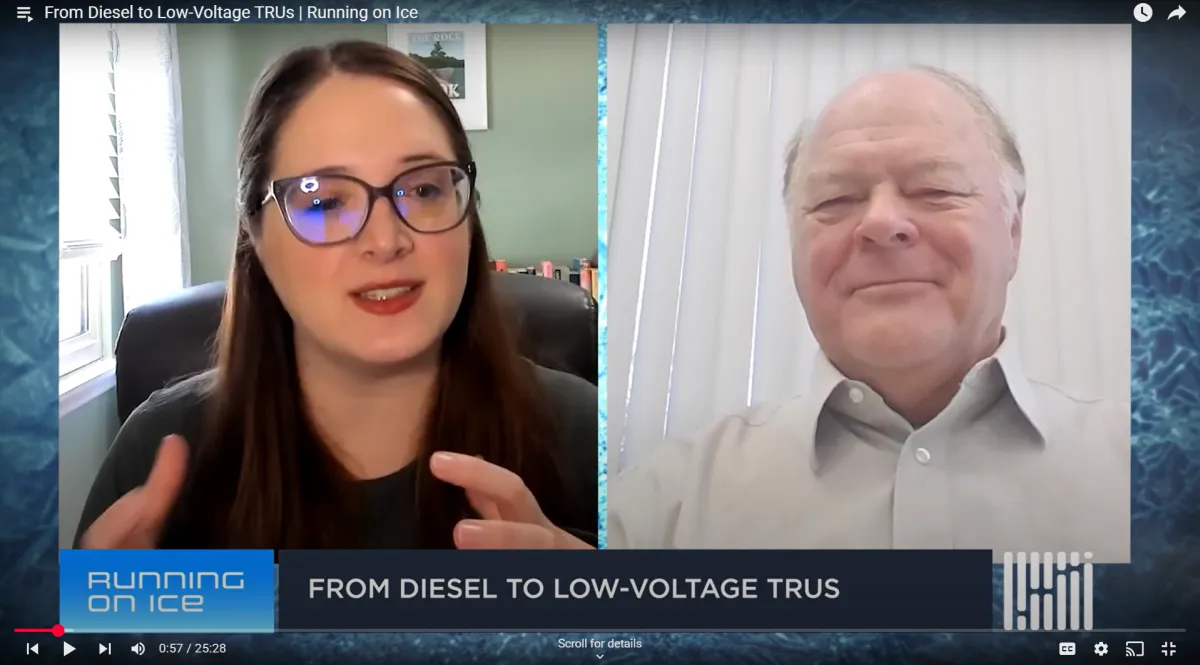Blog & Press Page
Achieving ESG & Zero Emissions
Cleaning up Cold Chain...


Solving Electrical Infrastructure Roadblocks and AIM Act Regulations for Food Distributors in the US
Notice Mary starts this interview about electrification infrastructure for food distributors with a question about the AIM Act. Just as everything in life boils down to our relationship with our mother, everything in food distribution and complying with all the environmental rules and regs, boils down to the electrical infrastructure decisions you make from the very beginning.
High voltage AC has been the only choice for decades, but some of the largest food distribution insiders in the US are going low voltage, thus reducing carbon while staying behind-the-meter, earning GWP and ESG clout, and going green in the black.

Now, Understanding the AIM Act and the F-Gas Regulation Schedule
In recent years, significant legislative measures have been enacted globally to address the environmental impacts of hydrofluorocarbons (HFCs) and other fluorinated gases (F-gases). Two prominent examples are the American Innovation and Manufacturing (AIM) Act in the United States and the European Union's F-Gas Regulation. This article delves into the specifics of these regulations, their objectives, and the timelines established for phasing down these potent greenhouse gases.
The American Innovation and Manufacturing (AIM) Act
Enacted by the U.S. Congress in December 2020, the AIM Act grants the Environmental Protection Agency (EPA) the authority to phase down the production and consumption of HFCs, manage these substances and their substitutes, and facilitate the transition to next-generation technologies through sector-based restrictions. epa.gov
The AIM Act outlines a phasedown schedule aiming for an 85% reduction in HFC production and consumption by 2036, using 2011-2013 levels as the baseline. The reduction steps are as follows:
2022: 10% reduction
2024: 40% reduction
2029: 70% reduction
2034: 80% reduction
2036: 85% reduction
This structured approach ensures a gradual transition, allowing industries to adapt and innovate with environmentally friendly alternatives. epa.gov
The European Union's F-Gas Regulation
The European Union has been proactive in regulating F-gases, implementing the original F-Gas Regulation in 2015. This regulation established a quota system and sector-specific bans to reduce the use of high global warming potential (GWP) refrigerants. danfoss.com
Building on this foundation, the EU adopted Regulation (EU) 2024/573 on February 7, 2024, which came into effect on March 11, 2024. This updated regulation introduces more stringent measures, including:
Enhanced Phasedown Schedule: Aims for a significant reduction in the use and emissions of high-GWP F-gases, promoting the adoption of alternative solutions. normecverifavia.com

New Rules on Labeling, Reporting, and Certification: Mandates detailed labeling of products containing F-gases, comprehensive reporting requirements for companies, and updated certification processes for technicians handling these substances. climate.ec.europa.eu
Sector-Specific Prohibitions: Implements bans on the use of certain F-gases in specific applications where safer alternatives are available.
The EU's phasedown schedule is designed to achieve a gradual reduction in F-gas usage, with the ultimate goal of phasing out all F-gases by 2050. This approach provides industries with a clear timeline to innovate and transition to sustainable alternatives. ecostandard.org
Global Impact and Industry Adaptation
Both the AIM Act and the EU's F-Gas Regulation reflect a global commitment to mitigating climate change by targeting potent greenhouse gases. Industries affected by these regulations are investing in research and development to create and adopt environmentally friendly alternatives. The phasedown schedules offer a structured pathway, encouraging innovation while providing time for adaptation.
In the United States, the AIM Act not only addresses environmental concerns but also aims to bolster economic growth by promoting the manufacture of next-generation technologies, including refrigerants, solvents, fire suppressants, foam blowing agents, aerosols, and propellants. congress.gov
Similarly, the EU's updated F-Gas Regulation is expected to drive innovation and green investment across a wide range of sectors, supporting decarbonization goals and signaling to the market the necessity of moving away from F-gases. eeb.org
Conclusion
The AIM Act and the EU's F-Gas Regulation represent significant strides in global environmental policy, targeting the reduction of HFCs and F-gases through structured phasedown schedules. These regulations not only aim to mitigate the environmental impact of these potent greenhouse gases but also encourage industries to innovate and transition to sustainable alternatives, contributing to broader climate change mitigation efforts.
We appreciate you as much as you appreciate us
Send your stories too!
Let's keep our air clean & efficiencies flowing!
Copyright Advanced Energy Machines ©2025 All rights reserved






